|
Click pictures for a larger version.
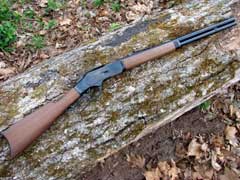
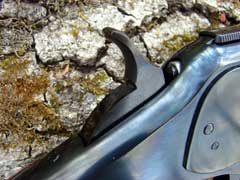
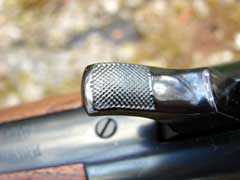
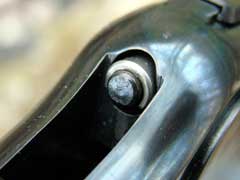
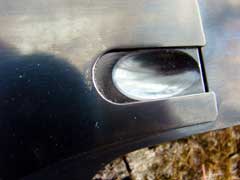
Magazine loading gate.


Lever latch.
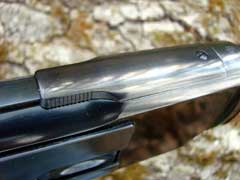
Sliding dust cover.
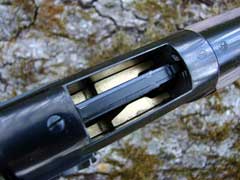
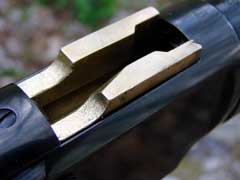

Lever-activated sear safety.
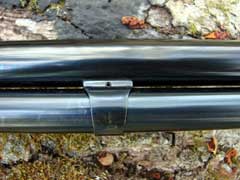
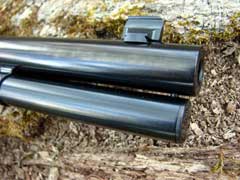


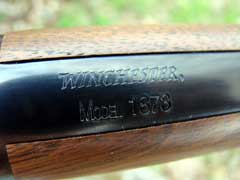
|
|
The year 1873 was one of the most significant
in the history of firearms. That year saw the introduction of
two of the most-famous and recognizable firearms in the world;
the 1873 Colt Single Action Army revolver, and the 1873
Winchester lever-action rifle, the latter of which is the
subject of this review.
The 1873 Winchester rifle retained the
butter-smooth action of its predecessors; the Henry and the
1866. It also had the easy-loading King's patent loading gate on
the right side of the receiver as did the 1866. The significance
of the 1873 was that it was the first rifle to chamber the
comparatively powerful 44 WCF (Winchester Center Fire)
cartridge. The 44 WCF (44-40) was a lot more powerful than the
44 Rimfire cartridge that was used in the Henry and the 1866.
Besides it packing more power, the WCF cartridges were also
reloadable, using the handy loading tool that was invented by
Oliver Winchester's son, William. This was an important feature
for a man on the frontier that had no ready source of
ammunition.
The 1873 Winchester rifle was also stronger
than its predecessors, and was built specifically to handle the
longer WCF cartridges. The frame of the 1873 was made from iron
instead of brass, and the ejection port had a sliding dust cover
on top, to keep out the elements in harsh environments. The '73
was offered in many variations, including rifle, carbine, and
musket. The 1873 was built from 1873 through 1923, being
officially dropped in 1924, with almost three-quarters of a
million rifles built. The 1873 could be ordered with an wide
variety of custom options, such as half round/octagon barrels,
gold, nickel, and silver plating, custom barrel lengths, and
various amounts of engraving coverage. In addition to the 32,
38, and 44 WCF cartridges, the 1873 was also chambered for the
22 Short and Long rimfire cartridges. Oliver Winchester was very
good at marketing, and gained a lot of publicity by putting his
rifles into the hands of famous people of the time, and also
with his "One of One Thousand" and "One of One
Hundred" rifles. The '73 is one of the most famous rifles
in history, and bears the unofficial title of "The Gun That
Won The West".
While Italian replica 1873 rifles and
carbines have been imported into the US for many years, and most
are quite good, it has been ninety years since the Winchester
brand has been roll-marked upon a '73, but now Winchester has
just reintroduced the 1873 Short Rifle, and it is available in
the US. Made by Miroku in Japan, the Winchester 1873 Short Rifle
wears a round barrel and a blued steel receiver. The wood is
straight-grained satin-finished walnut, and the '73 wears a
rifle-style crescent buttplate, with a blued-steel forearm cap.
The sights consist of a semi-buckhorn rear, with a Marble
gold-bead (brass) front. The rear sight is step-adjustable, and
both front and rear can be drifted in their dovetails for
windage correction.
The new Model 1873 Short Rifle is available
chambered for the 44 WCF (44-40), 45 Colt, or the 357 Magnum
cartridges, the latter of which will also fire 38 Special
ammunition, which is significant to those who desire to use the
rifle for Cowboy Action competition.
In that sport, speed of fire is very important, and the low
recoil and relatively low cost of ammunition makes the 38
Special cartridge a favorite, in both the competitor's sixgun
and his rifle.
The 1873 Winchester shown here is beautifully
polished, and the wood is fitted very well, with only a slight
bit of proudness where it meets the blued steel. The action is,
as expected, butter-smooth. There are no visible tool marks, and
the rifle's metal is finished flawlessly, as I have come to
expect from Miroku. The '73 weighs in at seven pounds, seven
ounces on my scale. The trigger pull is perfect, releasing
crisply with slightly over two and three-quarters pounds of
resistance. The rifle incorporates the lever-actuated sear
safety, as did all Winchester 1873 rifles manufactured after
1880. The twenty-inch round barrel measures .876 inch diameter
at the front of the receiver, and tapers to .72 inch at the
muzzle. The magazine tube diameter on this 357 Magnum measures
.646 inch diameter outside.
The Winchester 1873 Short Rifle has an
overall length of 39.05 inches, measured from the buttplate to
the muzzle. The length of pull measures thirteen inches, and the
drop at the heel is three inches, making for a very
comfortable-feeling rifle to me. The magazine tube holds eleven
38 Special cartridges, or ten 357 magnum cartridges.
The Winchester 1873 Short Rifle functioned
perfectly with normal 38 Special and 357 Magnum ammunition,
including several forms of hollowpoint and solid-bullet ammo,
including some blunt 180 grain cast lead ammunition. The only
ammunition that would not function, and I expected that it would
not, was some Atomic reverse-hollowbase wadcutter loads. These
loads work well in revolvers, but are too short to function
properly in a levergun. Still, I had to try, but the ammo not
working is no fault of rifle nor the ammunition. They are just
not compatible. Every other type of ammo tried functioned
perfectly. The rifle fed, fired, and ejected flawlessly, with
the empty cases falling clear of both the rifle and the shooter.
The
following loads were checked for velocity from the Winchester's
twenty-inch barrel, with impressive results. The 357 Magnum has
a lot more power when fired from a closed-breech rifle barrel
than when fired from a revolver, with the best loads approaching
30-30 Winchester power, while firing a
fatter bullet and with lower recoil. JHP is a jacketed
hollowpoint bullet. LHP is a lead hollowpoint. TAC-XP, XPB, and
DPX are Barnes homogenous hollowpoint bullets. LFN-GC is a
hard-cast lead flatnose gas-checked bullet. LRN is a soft lead
roundnose bullet. +P indicates ammunition loaded above SAAMI
specs for standard 38 Special ammunition. Bullet weights are
listed in grains. Velocities were recorded ten feet from the
muzzle, at an elevation of 541 feet above sea level, with an air
temperature of seventy-three degrees Fahrenheit, and a relative
humidity of forty-eight percent. Velocities are listed in
feet-per-second (fps).
| Ammunition |
Bullet Weight |
Velocity |
38 Special +P
|
|
|
| Atomic LHP |
148 |
1235 |
| Cor-Bon DPX |
110 |
1341 |
| Remington JHP |
125 |
1351 |
| Buffalo Bore TAC-XP |
110 |
1605 |
38 Special Standard Pressure
|
|
|
| Buffalo Bore TAC-XP |
110 |
1463 |
| Buffalo Bore LHP |
158 |
1234 |
| Peters LRN |
158 |
981 |
357 Magnum
|
|
|
| Buffalo Bore XPB |
125 |
2233 |
| Buffalo Bore LFN-GC |
180 |
1850 |
| Atomic JHP |
158 |
1929 |
| Remington JHP |
125 |
1672 |
| Cor-Bon DPX |
125 |
2033 |
| Cor-Bon JHP |
140 |
1761s |
As stated above, velocities were impressive.
Note that the 357 Magnum Buffalo Bore and Cor-Bon 125 grain
loads use the same Barnes bullet, but the Buffalo Bore load is
running a full 200 fps faster. That is an excellent load for
whitetail deer, hogs, or for social work, with very impressive
bullet expansion and deep penetration.
Accuracy was also very good, limited only by
the ability of my eyes to clearly see open sights. Still, this
rifle proved to be very accurate, with most ammo grouping under
one and one-half inches at fifty yards, and the largest group
fired measuring two and one-half inches. With some loads, I
think this rifle would group into one ragged hole, with a better
shooter pulling the trigger.
I am glad to see that Winchester is once
again paying attention to the lever action fans in this country,
and there are many. MSRP on this new 1873 is $1299.99 US, as of
the date of this review, which is not inexpensive, but it is
also priced right in there with the better Italian rifles, such
as the Cimarron. Winchester has, over the past few years, sold
other Miroku-produced leverguns, and they have all been very
well-made rifles. This new 1873 is no exception, and it is good
to see the Winchester brand upon the "Gun That Won The
West".
Check out the new 1873 and other Winchester
firearms and accessories online at www.winchesterguns.com.
For the location of a Winchester dealer near
you, click on the DEALER FINDER at www.lipseys.com.
To order the 1873 rifle online, click on the
Gun Genie at www.galleryofguns.com.
To
order quality 38 Special and 357 Magnum ammunition, go to www.buffalobore.com,
www.midsouthshooterssupply.com,
www.doubletapammo.com,
and www.luckygunner.com
Jeff Quinn
  
Got something to say about this article?
Want to agree (or disagree) with it? Click the following link to
go to the GUNBlast Feedback Page.
|
|
Click pictures for a larger version.
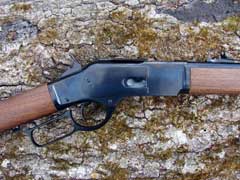
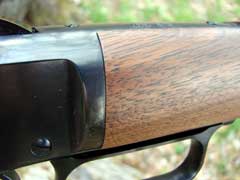
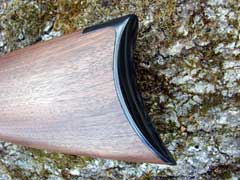

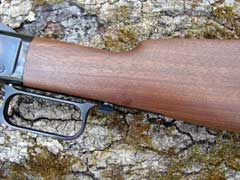

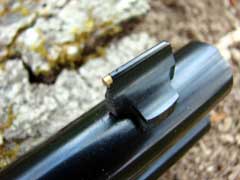
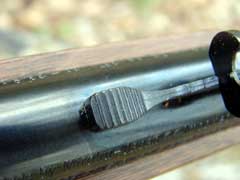
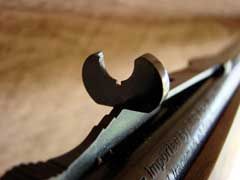
Step-adjustable semi-buckhorn rear sight with brass-bead front.
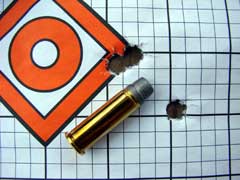
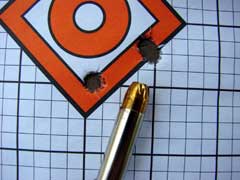
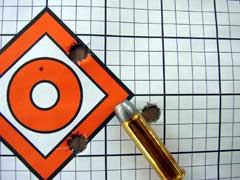
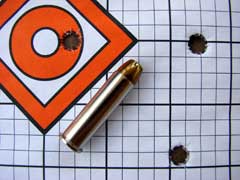
Fifty-yard accuracy was limited by the author's ability
to use the semi-buckhorn sight, but the rifle showed the
potential to be a one-holer at that distance, with the right
ammunition. Also shown is a two and one-half inch group, which
was the largest fired with any ammunition.
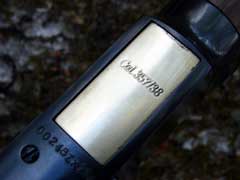
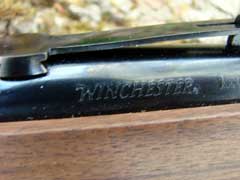
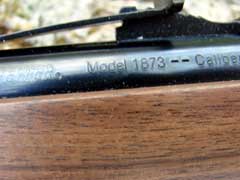
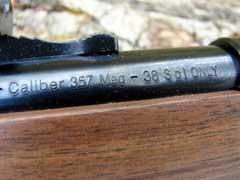
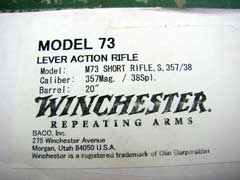
|
![]()